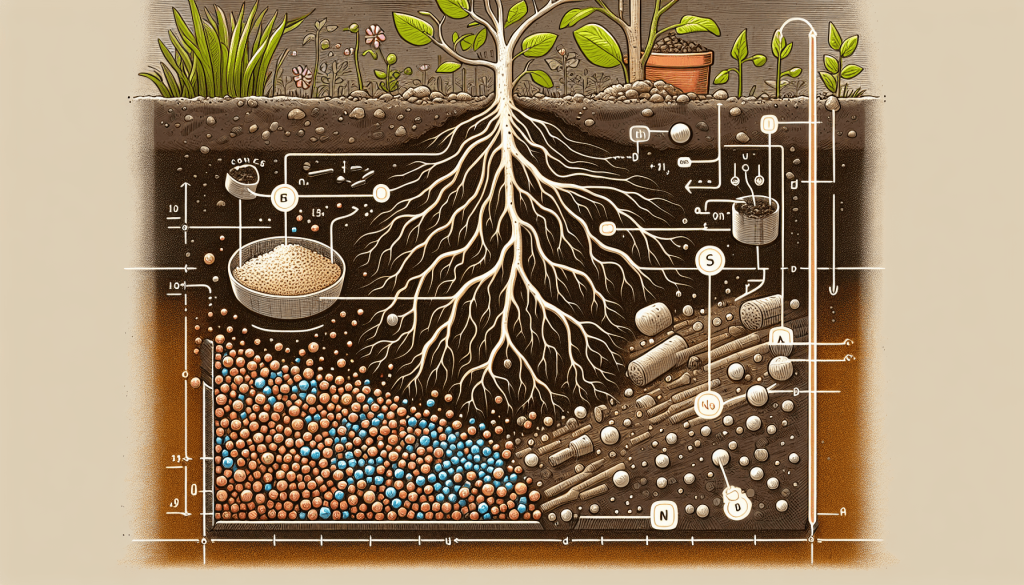This post may contain affiliate links. As an Amazon Associate, we may earn commissions from qualifying purchases.
Understanding the cation exchange capacity (CEC) of soil is crucial for optimizing nutrient availability in your garden or farm. CEC is a measure of the soil’s ability to hold and exchange cations (positively charged ions) like calcium, magnesium, and potassium, which are essential for plant health. Soils with higher CEC can retain more nutrients, making them available to plant roots over time. On the other hand, soils with low CEC may require more frequent fertilization. You can effectively improve your soil’s CEC by incorporating organic matter such as compost or peat moss, or mineral amendments like clay or biochar. These additions not only enhance nutrient retention but also improve soil structure and its overall fertility.
How Does The Cation Exchange Capacity (CEC) Of Soil Influence Nutrient Availability, And What Amendments Can Alter CEC Effectively?
Have you ever wondered how it is that plants get hold of all those essential nutrients from the soil? It’s fascinating how something as microscopic as soil composition can have such a significant impact on plant health and growth. This all boils down to a feature of soil called the Cation Exchange Capacity, or CEC. Understanding CEC and knowing how to manipulate it can make a huge difference in your gardening or farming endeavors.

What is Cation Exchange Capacity (CEC)?
Cation Exchange Capacity (CEC) is a measure of how well soil can retain and supply cations to plant roots. Cations are positively charged ions, such as calcium (Ca²⁺), magnesium (Mg²⁺), potassium (K⁺), and sodium (Na⁺). The soil’s CEC is essentially a measure of its ability to hold onto these essential nutrients and make them available to plants.
How Does CEC Work?
Soil particles, particularly clay and organic matter, have negatively charged sites that attract and hold positively charged cations. Higher CEC means the soil can store more cations, acting like a reservoir of essential nutrients. When plants take up cations from the soil solution, these sites release more cations to maintain balance.
To visualize CEC, think of it like a bank account for soil nutrients. The more negative sites the soil has (higher CEC), the more cations (nutrients) it can hold, and the better it can support plant growth.
Factors Influencing CEC
Several factors can influence the CEC of soil, including:
- Soil Texture: Clay soils generally have higher CEC because of their smaller particle size and larger surface area, which can attract more cations.
- Organic Matter: Soils rich in organic matter (humus) tend to have higher CEC. Organic matter decomposes to form humus, which significantly boosts the soil’s nutrient-holding capacity.
- Soil pH: Soil pH can affect the number of cation exchange sites. A neutral to slightly acidic pH is generally optimal for maintaining high CEC.
How CEC Influences Nutrient Availability
CEC plays a crucial role in nutrient availability, which in essence, dictates how well plants can access the nutrients they need for growth.
Nutrient Retention
Soils with high CEC can retain more nutrients. This retention prevents essential nutrients from being washed away by water (leaching), keeping them available for plant roots to absorb. Sandy soils, which have low CEC, are less effective at holding nutrients, making them more susceptible to nutrient leaching.
Buffering Capacity
High CEC soils have better buffering capacity, which means they can better maintain stable pH levels and resist rapid changes in soil chemistry. This is crucial for nutrient availability since extreme pH levels can lock up nutrients, making them unavailable to plants.
Fertilizer Efficiency
With high CEC, you can often apply fertilizers less frequently because the soil retains the nutrients longer. Conversely, in soils with low CEC, fertilizers need to be applied more often and in smaller amounts to avoid nutrient leaching and wastage.
Amendments to Alter CEC Effectively
Understanding the importance of CEC brings us to the practical question: how can you enhance your soil’s CEC to improve nutrient availability?
Organic Matter
Adding organic matter is one of the most effective ways to boost soil CEC. Compost, manure, leaf mold, and cover crops are excellent sources of organic matter. As these materials decompose, they increase the organic content and help build humus, leading to higher CEC.
Clay Minerals
Incorporating clay minerals like bentonite or vermiculite into sandy soils can improve CEC. These clay particles have a high surface area and negative charges that can attract and hold more cations.
Biochar
Biochar is a stable, carbon-rich form of charcoal that, when added to soil, can enhance CEC and improve nutrient retention. Biochar also has the added benefit of sequestering carbon, making it a sustainable soil amendment option.
Liming
If your soil is acidic, applying lime can increase soil pH and improve CEC. Liming materials like calcium carbonate (lime) or dolomitic lime (which also supplies magnesium) can raise the pH and enhance nutrient availability.
Table: Common Soil Amendments to Improve CEC
| Amendment | Primary Benefit | Application Rate |
|---|---|---|
| Compost | Adds organic matter and nutrients | 1-3 inches annually |
| Manure | Adds organic matter and nutrients | 20-30 tons/acre annually |
| Biochar | Increases CEC and retains nutrients | 5-10% of soil volume |
| Bentonite Clay | Enhances nutrient retention in sandy soils | 2-10 tons/acre |
| Lime | Raises pH and improves CEC in acidic soils | 1-2 tons/acre (depending on pH) |
Steps to Test and Adjust Your Soil’s CEC
If you’re serious about improving your soil’s CEC and optimizing nutrient availability, it’s essential to know where you stand. Follow these steps to test and adjust your soil’s CEC:
Testing Soil CEC
Testing your soil’s CEC can give you a baseline to work from. Many soil testing labs can perform this test, and some home testing kits also offer CEC measurements.
- Collect Soil Samples: Gather soil samples from different areas of your garden or field.
- Send to Lab or Use Test Kit: Send the samples to a soil testing lab or use a reputable home testing kit.
- Analyze Results: Review the results to understand your soil’s CEC level and nutrient profile.
Adjusting Soil CEC
Once you know your soil’s CEC, you can take targeted actions to adjust it:
- Incorporate Organic Matter: Add compost, manure, or leaf mold to the soil to boost organic content.
- Add Clay Minerals: For sandy soils, integrate clay minerals like bentonite to increase CEC.
- Apply Biochar: Mix biochar into the soil to enhance CEC and improve nutrient retention.
- Adjust pH: Use lime to raise the pH in acidic soils, improving CEC and nutrient availability.
Monitoring Progress
Regular soil tests can help you monitor changes in your soil’s CEC and nutrient levels over time. Adjust your soil management practices based on these results to maintain optimal conditions for plant growth.

Practical Tips for Managing CEC in Different Soil Types
Different soil types require different approaches to manage CEC effectively. Here’s a quick guide to help you optimize CEC based on your soil type:
Sandy Soils
Sandy soils have low CEC and poor nutrient retention. To boost their CEC:
- Add Organic Matter: Incorporate plenty of compost and aged manure.
- Use Mulch: Apply mulch to reduce nutrient leaching and improve moisture retention.
- Introduce Biochar: Mix in biochar to enhance CEC and retain nutrients.
Clay Soils
Clay soils generally have high CEC but can suffer from poor drainage and compaction:
- Amend with Organic Matter: Add compost to improve soil structure and aeration.
- Avoid Over-Tilling: Minimize tillage to prevent compaction.
- Use Cover Crops: Plant cover crops to enhance soil structure and organic content.
Loamy Soils
Loamy soils have balanced texture and CEC, making them ideal for plant growth:
- Maintain Organic Matter: Regularly add compost to sustain high CEC.
- Monitor Soil pH: Keep an eye on soil pH and adjust with lime or sulfur as needed.
- Rotate Crops: Practice crop rotation to maintain soil health and nutrient balance.
Benefits of Improving Soil CEC for Sustainable Agriculture
Enhancing your soil’s CEC isn’t just about better plant growth—it’s also a step towards more sustainable and environmentally friendly agriculture.
Reduced Fertilizer Use
High CEC soils retain nutrients better, reducing the need for frequent fertilizer applications. This not only saves you money but also minimizes the risk of nutrient runoff, which can contaminate water sources.
Improved Soil Health
Adding organic matter and biochar to boost CEC also improves soil health by enhancing its structure, moisture retention, and microbial activity. Healthy soil is the foundation of productive and sustainable farming.
Enhanced Crop Yields
Optimal nutrient availability leads to healthier plants and higher yields. By managing your soil’s CEC, you can ensure that your crops have access to the essential nutrients they need to thrive.
Climate Resilience
Soils with higher organic matter content and CEC are better equipped to withstand extreme weather conditions, such as droughts and heavy rains. This resilience can help protect your crops and sustain productivity in the face of climate change.
Common Misconceptions About CEC
There are a few common misconceptions about CEC that can lead to confusion or suboptimal soil management practices. Let’s clear up some of these misconceptions:
CEC is the Only Factor Affecting Nutrient Availability
While CEC is crucial for nutrient retention and availability, it’s not the only factor. Soil pH, microbial activity, and the presence of other nutrients and organic matter also play significant roles. It’s important to consider these factors holistically for optimal soil management.
High CEC Always Means High Fertility
High CEC soils can hold more nutrients, but this doesn’t automatically translate to high fertility. Nutrient levels still need to be balanced and adequate for plant growth. Regular soil testing and balanced fertilization are essential for maintaining soil fertility.
You Can Rapidly Change CEC
Improving CEC is a gradual process that requires consistent soil management practices. Adding organic matter or clay minerals can boost CEC over time, but it’s not an overnight fix. Patience and persistence are key.
Future Trends and Research in CEC Management
Soil science is continually evolving, and new research and technologies are enhancing our understanding and management of CEC.
Innovative Soil Amendments
Advances in soil amendments, such as designer biochars and microbial inoculants, are offering new ways to boost CEC and improve soil health. These innovations hold promise for more effective and sustainable soil management practices.
Precision Agriculture
Precision agriculture technologies, such as soil sensors and data analytics, allow for more accurate monitoring and management of soil CEC. These tools enable farmers to make data-driven decisions and optimize nutrient management practices.
Climate-Smart Agriculture
As climate change impacts agriculture, there is increasing focus on climate-smart practices that enhance soil resilience. Improving CEC through organic matter addition and other sustainable practices can help build soil resilience and support climate adaptation efforts.
Conclusion
Understanding and managing the cation exchange capacity (CEC) of your soil is a critical aspect of successful gardening and farming. By recognizing the factors that influence CEC and implementing effective soil amendments, you can enhance nutrient availability, improve plant health, and contribute to sustainable agricultural practices. So go ahead and test your soil, make the necessary adjustments, and watch your garden or crops thrive like never before. Happy gardening!








